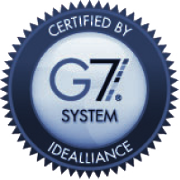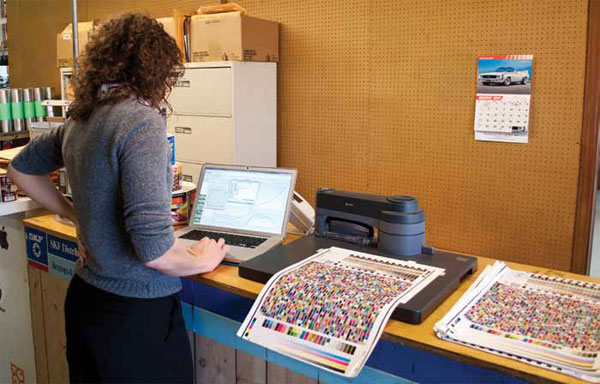The promised primary benefit of G7 is that you're getting the very best color management available today. G7 Masters have to prove that they can match proof to press results - so you can show your customers that you run to tighter process controls for color accuracy and predictability.
We are often asked questions about G7 and if adopting its standards is something they should consider doing at this time. Below are some questions to consider in making this decision.

Is your process optimized and under control (repeatable)?
Your process must be repeatable, meaning you can print to the same densities and dot gain using the same established print parameters. This can be assessed by completing 2 or more characterization runs or using print run targets on multiple press runs and evaluating the print results.
Do you need to handle prepress in-house?
No; however, this process must closely involve both the prepress and production teams. Multiple press runs are recommended for collection of data and to validate success of adjustments.
Do I need to apply G7 to my proofing process as well as my press?
Yes; however, the method for doing so is not necessarily the same. In some cases, depending on your proofing RIP, it may be just as effective to use the proofing calibration process or profiles. Regardless, you will point the proof to match the same near-neutral target.
Do I have to target "ISO 12647-2" or "GRACoL2006 coated 1" colorant and substrate L*a*b* specifications?
At this point, this is the generally accepted target for defining gray for all print processes. Though you may not be able to achieve the target print densities or L*a*b* values for GRACoL 7®, it is still an effective target for helping to define a common print appearance amongst all your print presses and processes. There is a committee within the FTA that is working to establish a near-neutral standard more targeted for Flexographic printing on film.

What is required to start using G7?
Tools you will need include an EyeOne and a densitometer or other spectro-densitometer. You will need at the very least a densitometer press-side. Prepress will need the ability to measure both spectral and density data. You will also need the P2P target which can be downloaded for free from the IDEAlliance® website (www.idealliance.org). You can analyze the P2P target manually, charting results on graph paper (also a free download from IDEAlliance®) or purchase software used to analyze the P2P target. Currently most of the software requires input from the EyeOne. There are also other software options that allow you to use the IT8.7-4 to gather data and convert this target’s data into a P2P while also collecting information for profiling. This can also be effective as a tool to validate your results.
What is NNC and how does it relate to G7?
NNC stands for Near Neutral Calibration. Both are targeting a neutral gray but G7 specifically references ISO 12647-2 to define the target neutral gray and the ink and substrate ingredients. FTA FIRST 4.0 does not endorse any one product but does support the concept of near neutral calibration. G7 is owned and monitored by IDEAlliance®.
Do I have to use ISO certified inks and meet the ISO 12647-2 print standards?
No. If you are not interested in becoming a G7 Master, you may still apply the methodology of this process to gray balance your process. There are four levels of G7 compliance, the second of which is the only one to require use of ISO certified colorants and substrate.
- G7 Grayscale: A device or process is in "G7 Grayscale" compliance when it is calibrated to the basic G7 definition of constant neutral grayscale appearance. So you do not need to use ISO certified inks or substrate.
- G7 Targeted: A device or process is in "G7 Targeted" compliance when it is G7 Grayscale calibrated and meets standard colorimetric measurements for substrate and colorants, such as those in ISO 12647-2.
- G7 Characterized: A device or process is in "G7 Characterized" compliance when it is G7 Grayscale calibrated and is controlled (for example with ICC profiles) to match a print specification that is itself based on G7.
- G7 Extreme: A device or process is in "G7 Extreme" compliance when it is G7 Grayscale calibrated, and has a significantly greater natural color space than any G7 Characterized specification, and can be optionally controlled (for example with ICC profiles) to match any G7 Characterized color space.
Why are some print buyers making G7 a requirement?
Typically a print-buy is either distributed geographically or distributed across different print types. So, for example, a buyer may want to purchase marketing collateral, packaging and signage with the same brand imagery. Clearly the substrate, gamut and other print characteristics will vary for the different print products. But if all the print products have the same gray balance and neutral tonality defined by G7, they will look remarkably alike to the human eye. Because buyers believe the similarity of the visual appearance across print products is critical, they now make G7 a buying requirement.
What is a G7 Master?
G7 Master Status is granted to a physical facility, equipment and systems. Example: ABC Printing Company’s proofing and printing presses have been G7 Master Qualified. G7 Master Qualification is valid for one calendar year and must be renewed annually. The company must also be a member of either IDEAlliance or the G7 Network in good standing. Note that this is not a Certification, it is a Qualification. No tolerances are imposed at this time. The program may evolve into a true certification in the future as industry data is gathered to support a certification process.
Do I have to hire a G7 Expert to apply G7 principles?
No. If you are not interested in becoming a G7 Master, you may still apply the methodology of this process to gray balance your process. If you are interested in becoming a G7 Master, you can either hire a G7 Expert Consultant or send one of your own employees to become a G7 Professional. To have your location become G7 Master Qualified, the following must happen:
- A G7 Expert must work with you to educate your staff about G7 and calibrate your proofing systems and/or presses.
- If you have your own in-house G7 Professional trained by IDEAlliance, that person can calibrate your systems, but a G7 Expert must review and approve the calibration data to finalize the qualification. G7 Professionals do not need a G7 Expert to review their data for the annual Masters re-qualification.
- Your company must be a member in good standing of either IDEAlliance or the G7 Network.
What is a G7 Professional and a G7 Expert?
- A G7 Professional is generally an in-house quality/technical person who has attended and passed an IDEAlliance G7 Professional Training Seminar. Typically larger print facilities with multiple manufacturing locations may send a corporate technical person for G7 Professional training. G7 Professional certification is valid for 2 calendar years. The G7 Professional can maintain their certification as long as they remain employed with the same company as originally certified and the company remains a member of either IDEAlliance or the G7 Network in good standing. If you change jobs, you can transfer your certificate to your new place of employment, but your new employer must become a GRACoL/G7 Network Member.
- A G7 Expert is an expert in the field of color management, process and quality control for proofing and printing equipment. An Expert is able to analyze color and print related issues and take corrective action to bring systems and processes in control to a set method, standard or specification with repeatable predictable results. Generally a G7 Expert. makes his/her living as a consultant to the agency/print/publishing industry. G7 Expert Certification is valid for 2 calendar years. The G7 Expert must qualify a minimum of three G7 Master Facilities per calendar year to maintain their G7 Expert status.
About the Author: Catherine Haynes is a member of the Technical Solutions Group for All Printing Resources. She has more than 15 years of experience in the printing industry and has been a certified G7 Expert for more than 2 years. At present, Haynes chairs FLEXO Magazine's Editorial Advisory Committee. For more information, contact her using our online Training Info Request Form.
